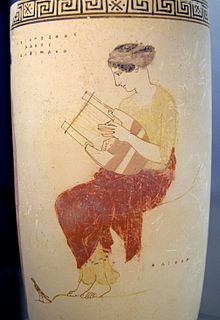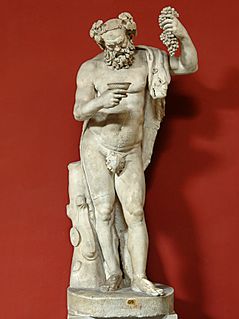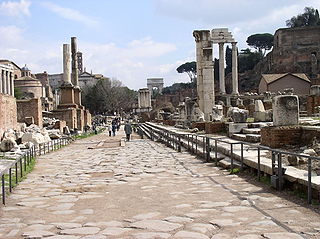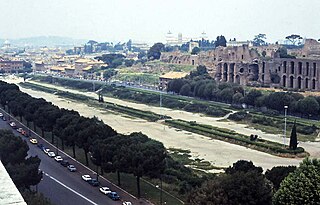
The Circus Maximus is an ancient Roman chariot-racing stadium and mass entertainment venue located in Rome, Italy. Situated in the valley between the Aventine and Palatine Hills, it was the first and largest stadium in ancient Rome and its later Empire. It measured 621 m (2,037 ft) in length and 118 m (387 ft) in width and could accommodate over 150,000 spectators. In its fully developed form, it became the model for circuses throughout the Roman Empire. The site is now a public park.

The Roman triumph was a civil ceremony and religious rite of ancient Rome, held to publicly celebrate and sanctify the success of a military commander who had led Roman forces to victory in the service of the state or, originally and traditionally, one who had successfully completed a foreign war.

In ancient Roman religion and mythology, Liber, also known as Liber Pater, was a god of viticulture and wine, fertility and freedom. He was a patron deity of Rome's plebeians and was part of their Aventine Triad. His festival of Liberalia became associated with free speech and the rights attached to coming of age. His cult and functions were increasingly associated with Romanised forms of the Greek Dionysus/Bacchus, whose mythology he came to share.

Agrippa Postumus, also referred to as Postumus Agrippa, was the youngest son of Marcus Vipsanius Agrippa and Julia the Elder, daughter and only biological child of Emperor Augustus. At the time Augustus considered Postumus as a potential successor, but banished him from Rome in AD 6, for reasons that remain unknown. This, in effect, though not in law, cancelled his adoption and virtually assured Tiberius' position as Augustus' sole heir. Postumus was ultimately executed by his own guards shortly after Augustus' death in AD 14.
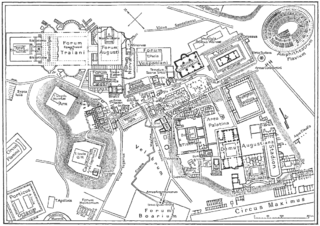
Vicus Tuscus was an ancient street in the city of Rome, running southwest out of the Roman Forum between the Basilica Julia and the Temple of Castor and Pollux towards the Forum Boarium and Circus Maximus via the west side of the Palatine Hill and Velabrum.

Chariot racing was one of the most popular Iranian, ancient Greek, Roman, and Byzantine sports. Chariot racing was dangerous to both drivers and horses as they often suffered serious injury and even death, but these dangers added to the excitement and interest for spectators. Chariot races could be watched by women, who were banned from watching many other sports. In the Roman form of chariot racing, teams represented different groups of financial backers and sometimes competed for the services of particularly skilled drivers. As in modern sports like football, spectators generally chose to support a single team, identifying themselves strongly with its fortunes, and violence sometimes broke out between rival factions. The rivalries were sometimes politicized, when teams became associated with competing social or religious ideas. This helps explain why Roman and later Byzantine emperors took control of the teams and appointed many officials to oversee them.

Festivals in ancient Rome were a very important part of Roman religious life during both the Republican and Imperial eras, and one of the primary features of the Roman calendar. Feriae were either public (publicae) or private (privatae). State holidays were celebrated by the Roman people and received public funding. Games (ludi), such as the Ludi Apollinares, were not technically feriae, but the days on which they were celebrated were dies festi, holidays in the modern sense of days off work. Although feriae were paid for by the state, ludi were often funded by wealthy individuals. Feriae privatae were holidays celebrated in honor of private individuals or by families. This article deals only with public holidays, including rites celebrated by the state priests of Rome at temples, as well as celebrations by neighborhoods, families, and friends held simultaneously throughout Rome.

The Floralia was a festival in ancient Roman religious practice in honor of the goddess Flora, held April 27 during the Republican era, or April 28 in the Julian calendar. The festival included Ludi Florae, the "Games of Flora" which lasted for six days under the empire.

The Circus Flaminius was a large, circular area in ancient Rome, located in the southern end of the Campus Martius near the Tiber River. It contained a small race-track used for obscure games, and various other buildings and monuments. It was "built", or sectioned off, by Gaius Flaminius in 221 BC.
The Ludi Romani was a religious festival in ancient Rome. Usually including multiple ceremonies called ludi. They were held annually starting in 366 BC from September 12 to September 14, later extended to September 5 to September 19. In the last 1st century BC, an extra day was added in honor of the deified Julius Caesar on 4 September. The festival first introduced drama to Rome based on Greek drama.
The Battle of Mount Algidus was fought in 458 BC, between the Roman Republic and the Aequi, near Mount Algidus in Latium. The Roman dictator Lucius Quinctius Cincinnatus turned an expected Roman defeat into an important victory.
The Megalesia, Megalensia, or Megalenses Ludi, was a festival celebrated in Ancient Rome from April 4 to April 10, in honour of Cybele, known to Romans as Magna Mater. The name of the festival derives from Greek Megale (μϵγάλη), meaning "Great". Ludi were the games or entertainments associated with religious festivals.
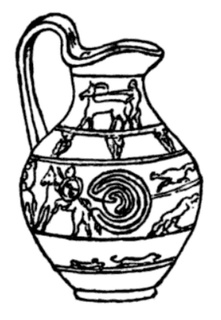
The Lusus Troiae, also as Ludus Troiae and ludicrum Troiae was an equestrian event held in ancient Rome. It was among the ludi ("games"), celebrated at imperial funerals, temple foundings, or in honor of a military victory. The lusus was occasionally presented at the Saecular Games, but was not attached regularly to a particular religious festival.
The Plebeian Games were an ancient Roman religious festival held November 4–17. The games (ludi) included both theatrical performances (ludi scaenici) and athletic competitions for the purpose of entertaining the common people of Rome.

The Trigarium was an equestrian training ground in the northwest corner of the Campus Martius in ancient Rome. Its name was taken from the triga, a three-horse chariot.

The Taurian Games were games (ludi) held in ancient Rome in honor of the di inferi, the gods of the underworld. They were not part of a regularly scheduled religious festival on the calendar, but were held as expiatory rites religionis causa, occasioned by religious concerns.
In the topography of ancient Rome, the Tarentum or Terentum was a religious precinct north of the Trigarium, a field for equestrian exercise, in the Campus Martius. The archaeological survey of the site shows that it had no buildings.
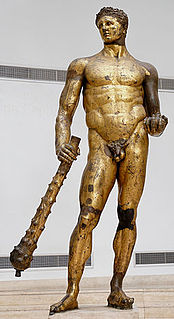
In ancient Roman religion and myth, Hercules was venerated as a divinized hero and incorporated into the legends of Rome's founding. The Romans adapted Greek myths and the iconography of Heracles into their own literature and art, but the hero developed distinctly Roman characteristics. Some Greek sources as early as the 6th and 5th century BC gave Heracles Roman connections during his famous labors.








